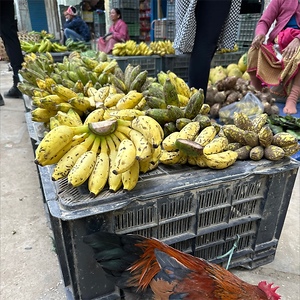


Seeni Bananas
Estimated Inventory, lb : 0
Description/Taste
Seeni bananas are small to medium in size, averaging 10 centimeters in length and under 2.5 centimeters in diameter, and have a short, thick appearance with a straight to slightly curved, cylindrical, and tapered shape. The uniform bananas also bear a distinct protruding, rounded tip on the non-stem end, sometimes labeled as the nose. The peel is smooth, taut, and thin with a rubbery consistency and ripens from bright green to buff or pale, muted yellow. The peel will also occasionally showcase brown markings, and the yellow hue is characteristically lighter than other commercial cultivars. Underneath the peel, the cream-colored flesh is sticky, dense, firm, and creamy when ripe, either being found seedless or containing seeds, depending on the variety. Seeni bananas release a perfumed, tropical, flowery, and fruity scent. The variety can be consumed raw when ripe and has a sweet, mild, and sugary taste.
Seasons/Availability
Seeni bananas are available year-round.
Current Facts
Seeni bananas, botanically a part of the Musa genus, are sweet, tropical fruits belonging to the Musaceae family. There are 29 varieties of bananas grown in Sri Lanka, and Seeni bananas are a common fresh-eating type widely sold in local markets. Seeni bananas grow on plants with pseudo stems reaching 2 to 4 meters in height and are an ABB cultivar within the Mysore banana subgroup. In Sri Lanka, the name Seeni translates to mean “sugar,” and the descriptor was given for the fruit’s sweet, honeyed taste. Seeni bananas are sometimes known as Seeni Kesel, Seeni Kehel, Honey bananas, and Sugar bananas. In the modern day, the variety is commercially cultivated and is a versatile fruit utilized in fresh and cooked culinary preparations.
Nutritional Value
Seeni bananas are a source of fiber to regulate the digestive tract, potassium to balance fluid levels, and iron to develop the protein hemoglobin for oxygen transport through the bloodstream. Like other banana varieties, the variety also provides calcium to build strong bones and teeth, magnesium to control nerve functioning, and other nutrients, including zinc, manganese, vitamin D, copper, and vitamin A. In Sri Lanka, Seeni bananas are a natural food for feeding children and the elderly. The fruits are also used in Ayurvedic medicine as an ingredient to calm the nervous system, and the peels are rubbed on insect bites to reduce itchiness.
Applications
Seeni bananas have a sweet, subtly tropical, and sugary taste suited for fresh and cooked preparations. The variety is popularly consumed out-of-hand in Sri Lanka and is a typical dessert banana. Seeni bananas are also sprinkled with cinnamon and eaten as a snack, blended into smoothies and milkshakes, or pureed and frozen into ice cream. Try incorporating the variety into fruit salads. In addition to fresh preparations, Seeni bananas can be incorporated into baked goods such as bread, muffins, pies, cakes, and cookies, simmered into jams or sauces, or mashed into pancakes. Seeni bananas can also be fried into fritters. In Sri Lanka, Seeni bananas are used in banana kavum, a deep-fried sweet, or they are grilled to develop caramelization. They are also sliced into coins and dried for extended use. Beyond the fruits, Seeni banana flowers are incorporated into sambals and stir-fries, served over rice. Seeni sambal is also a common dish served in lamprais, a meal of curries, meat, and various side dishes. Seeni bananas pair well with vanilla, chocolate, maple syrup, fruits such as citrus, papaya, mangoes, and coconut, nuts such as macadamia, peanuts, and cashews, and meats including pork, beef, poultry, and fish. Whole Seeni bananas should be stored at room temperature in a cool, dark place away from direct sunlight. Once ripe, the fruits will keep for a couple of days but should be immediately consumed for the best quality and flavor. Seeni bananas can also be frozen for extended use.
Ethnic/Cultural Info
In Sri Lanka, bananas are traditionally planted during Vaisakha, a month in the Hindu calendar that typically aligns with April or May in the Gregorian calendar. Planting banana plants is an auspicious practice as the species is closely tied to Vishnu, the god of the universe. It is also thought that life revolves around plants, and giving back to the Earth through planting outwardly shows gratitude and thankfulness. Banana plants are often a part of rituals, ceremonies, and acts of worship, and the fruit is honored as it is thought to welcome happiness and prosperity to households. At some temples, when a member cannot afford to offer a donation, also known as Dakshina, they can give bananas in place of money.
Geography/History
Seeni bananas are native to Southeast Asia and are a hybrid variety grown commercially and in home gardens. Much of the history of the variety is unknown, but Seeni bananas have an established presence in local markets throughout Sri Lanka and Southern India. Bananas have been grown in Sri Lanka for thousands of years and were first recorded in Sarartha Sangragaha, a medical manuscript by famed physician and King Buddhadasa. Seed remains have also been found in the Ratnapura District in Sri Lanka, considered over 12,000 years old. Over time, many varieties of bananas have been selectively bred in Sri Lanka for culinary, cultural, and medicinal purposes. Today, Seeni bananas are a common fresh eating, also known as a dessert banana. The variety is grown in the dry and intermediate zones and is typically found in local markets in Southern India and Sri Lanka. Seeni bananas are sold at roadside stands, directly through growers, and at select grocers.








